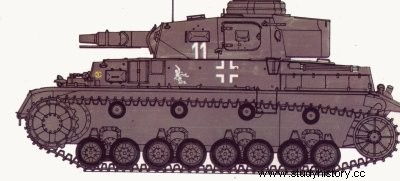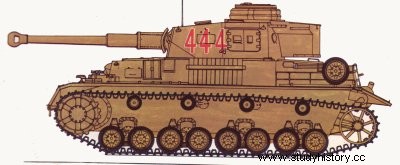
PzKpfw IV SdKlz 161
Country Germany
Type: medium tank.
Crew: 5 men.
Arming: a 7.5 cm KwK L/24 gun:a coaxial 7.92 mm MG34 a 7.92 mm MG34 in the hull.
Shielding: minimum 20mm:maximum 90mm.
Dimensions:
length 591 m;
width. 2.92 m.
height: 2.59 m.
Weight: 19.7 t.
Ground pressure: 075 kg/cm2.
Mass power: 15.5 bhp.
Engine :Maybach HL 120 TRM V-12 in-line diesel, developing 300 hp at 3,000 rpm.
Performance:
road speed: 40 km/h;
off-road speed. 20 km/h:
autonomy: 200km;
vertical obstacle 0.6m:
clean cut 2.3m;
ford: 0.8m;
slope: 30%.
Service time: in the German army from 1936 to 1945. Also employed by Spain, Italy and Turkey. Last employed by Syria in 1967. (Note:Data is for PzKpfw IV Ausf D).

The PzKpfw IV was the only German tank produced continuously from the first to the last day of World War II, arguably longer than any other tank of the time except the T-34.
The adventure began the day of 1935 when the great German general staff established the specifications providing for the main battle corps, two types of tanks, the most numerous (the PzKpfw III) mounting a gun with high initial speed and a tank of support mounting a large caliber cannon firing good explosive ammunition.
This machine was going to be the PzKpfw IV. The gun chosen from the start was the short-barreled 7.5 cm Kwk; moreover, the vehicle could not exceed the total weight of 24 t In fact the specifications required a machine very similar to the PzKpfw III, the organization of the two vehicles, as well as their respective missions. varying only on details.
Contract was made with several companies and again the development stretched over a relatively long period while the researchers refined the various designs.
Deliveries could not really begin until 1939 and at that time the research had led to the Ausführung D, the model which took part in the campaigns of Poland and France before launching into the great Russian spaces in 1941 and showing there shortcomings so obvious that it became impossible to close your eyes any longer.
The dimensions of the Aue D slightly exceeded those of the DzKpfw III but the shape of the hull and the general silhouette remained the same. The crew occupied three compartments:the driver and the radio-operator were installed in the front, the hull machine-gun to their right and a little behind the driver. In the combat room the turret housed the tank commander. the gunner and the outfitter.
Turret rotation was electrically operated while it was still manually operated on the PzKpfw III.
The prominent cupola at the rear of the turret offered the tank commander an unlimited field of vision. An escape hatch was drilled in each side wall of the turret. The engine, in the rear compartment, did not differ from that of the PzKpfw III only the arrangement of the accessories varied somewhat. The movement was transmitted to the gearbox and to the sprockets located at the front.
The suspension consisted of four coupled bogies on each side, suspended by leaf springs. A large idler wheel was at the rear and four small support rollers completed the bearing. The hull was spacious enough to carry 80 shells and 2,800 rounds of machine gun.
Fighting experience soon showed that in this form the craft was well designed and organized but that the armor was too thin for its true mission, supporting the PzKpfw IIIs, as it had virtually no advantage over other tanks. A further training program was therefore set in motion which was to continue uninterrupted until the end of the war. The next model, the E, received additional armor on the coaming and the turret. as well as a new dome.
This equipment was also adapted to older door models than today, precise identification on dst photo often difficult. The F model was supposed to become a main greenhouse model but it was soon, in turn, judged to be perfectible and it received a long tube version of the 7.5 cm This new weapon completely transformed the role of the vehicle which took the status of tank either support but combat under the PzKpfw III in this mission from head 1941.
Built in large numbers, the F fought on all fronts. as well as its immediate successor the G which was distinguished from it externally only by thicker armor and the appearance of side armored skirts
In 1943, the tank found a new youth with the 7.5 cm KwK 40 L148 gun, which allowed it to challenge any tank in the world and to take its place in a duel with the T-34.
The larger pieces had obviously changed the turret which, starting from the G, received additional armor which made it appear much longer at the rear. radical the silhouette of the tank. making him look chunky. and to be honest, a little unbalanced. Luttime Austinrung, the IVJ, came out in 1944. At that time. the slope* of raw materials became more acute and the design had to be simplified but the machine remained fundamentally the one which had started the war five years earlier
In 1945, more than 8,000 had been books. and many others built for specific missions Some IVs were still active in the Syrian army during the 1967 Arab-Israeli war excellent service records.
